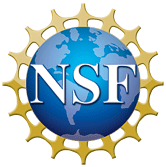Property:Describe key physical parameters
From CSDMS
This is a property of type Text.
U
Navier-Stokes primitive equations. Bio-optical, biogeochemical, and ecosystem models equations. Cohesive and non cohesive sediment equations. Several vertical turbulece equations (KPP, GLS, MY-2.5). Air-Sea interaction coupling equations (COARE). Bottom boundary layer model equations. +
C
Navier-Stokes primitive equations. Bio-optical, biogeochemical, and ecosystem models equations. Cohesive and non cohesive sediment equations. Several vertical turbulece equations (KPP, GLS, MY-2.5). Air-Sea interaction coupling equations (COARE). Bottom boundary layer model equations. +
G
Net N & P land surface balance (from inputs, incl. atm. deposition) modulated with calibrated runoff relationships to estimate exports to streams; point sources calculated from socioecon. and sewage treatment information; reservoir and consumptive water withdrawal loss using physical relationships. +
S
Newton's second law in the dynamic form is damped to acquire static or quasi-static solutions. Among importance parameters are those for a constitutive model (elastic moduli, linear and non-linear viscosity, and parameters for strain-weakening plasticity) and damping parameters. +
G
Nonlinear shallow water equations in conservation form are solved, with a Manning coefficient used to specify bottom friction. Coriolis terms can also be turned on. Multi-layer shallow water equations are also implemented. Equations can be solved in latitude-longitude coordinates on the sphere or in Cartesian coordinates, e.g. for limited-area or wave tank modeling. Wetting and drying algorithms handle inundation. +
O
Partial differential equations describing mass transport (Advection-Dispersion-Reaction equations) and algebraic equations describing chemical equilibria are coupled using the Sequential Iteration Approach +
G
H
C
P
Primitive equations for momentum, heat and salt fluxes, as well as TKE equations. +
S
Primitive equations.Non hydrostatic version available.
Sediment transport : cohesive (Partheniades) and non cohesive (Smith and Mac Lean). Biogeochemistry : cycle of C,N,P,Si +
P
Processes include: 2-D overland flow, 2-D groundwater flow, 1-D soil moisture, 1-D channel flow, snow/melt, et, vegetation water use by NLCD, +
W
Rain storm depth, storm duration, storm intensity - driving variables; effective hydraulic conductivity - controls infiltration into soil; baseline soil erodibility parameters (interrill erodibility, rill erodibility, critical hydraulic shear stress) - control soil detachment rates; slope inputs - control amount of flow shear stress and sediment transport capacity available to detach and tranport soil/sediment; plant growth parameters - control the production of biomass that protects soil surface; residue decomposition parameters - control the rate of residue loss from soil surface; tillage operation parameters - control the amount of soil disturbance and burial of residue - both of which impact the adjusted erodiblities for a given day. +
F
Reynolds number, settling velocity, Froude number (or bulk Richardson number), critical shear stress of erosion, Stokes number +
B
River and hillslope erosion coefficients, hillslope weathering parameters; initial block size, block release/motion thresholds, block weathering rate. +
S
SWAN contains a number of physical processes (see Scientific/Technical documentation) that add or withdraw wave energy to or from the wave field. The processes included are: wind input, whitecapping, bottom friction, depth-induced wave breaking, obstacle transmission, nonlinear wave-wave interactions (quadruplets and triads) and wave-induced set-up. SWAN can run in several modes, indicating the level of parameterization. SWAN can operate in first-, second- and third-generation mode. The first- and second-generation modes are essentially those of Holthuijsen and De Boer (1988); first-generation with a constant Phillips "constant" of 0.0081 and second-generation with a variable Phillips "constant". An overview of the options is given in Table below. +
SWMM conceptualizes a drainage system as a series of water and material flows between several major environmental compartments. These compartments and the SWMM objects they contain include:
* The Atmosphere compartment, from which precipitation falls and pollutants are deposited onto the land surface compartment. SWMM uses Rain Gage objects to
represent rainfall inputs to the system.
* The Land Surface compartment, which is represented through one or more Subcatchment objects. It receives precipitation from the Atmospheric compartment in the form of rain or snow; it sends outflow in the form of infiltration to the Groundwater compartment and also as surface runoff and pollutant loadings to the Transport compartment.
* The Groundwater compartment receives infiltration from the Land Surface compartment and transfers a portion of this inflow to the Transport compartment. This compartment is modeled using Aquifer objects.
* The Transport compartment contains a network of conveyance elements (channels, pipes, pumps, and regulators) and storage/treatment units that transport water to outfalls or to treatment facilities. Inflows to this compartment can come from surface runoff, groundwater interflow, sanitary dry weather flow, or from user-defined hydrographs. The components of the Transport compartment are modeled with Node and Link objects.
Not all compartments need appear in a particular SWMM model. For example, one could model just the transport compartment, using pre-defined hydrographs as inputs. +
N
Search window radius: The distance around each cell over which to evaluate the non-local mean.
Similarity Window Radius: The distance around each cell in the neighbourhood over which to evaluate the mean.
Degree of filtering: The weighting for the gaussian kernel controlling the strength of filtering and therefore the decay of weights as a function of distance from the centre of the kernel. +
